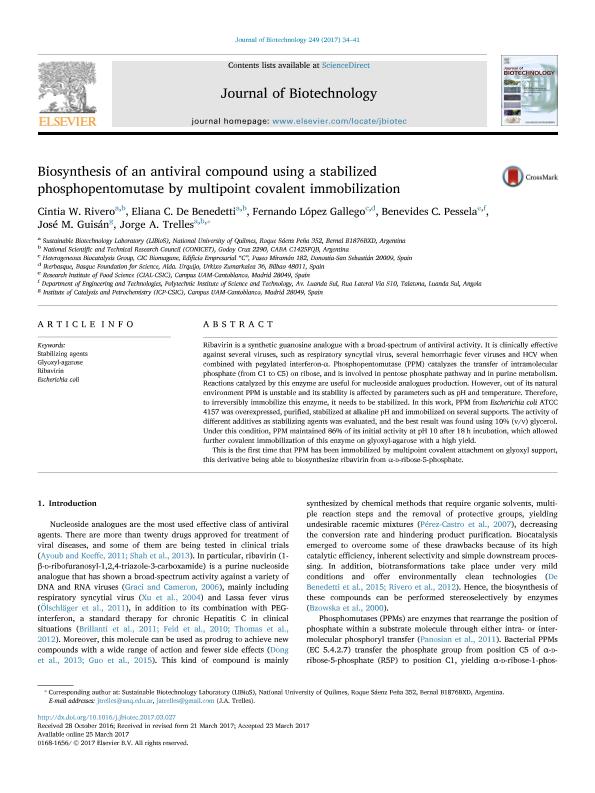Artículo
Biosynthesis of an antiviral compound using a stabilized phosphopentomutase by multipoint covalent immobilization
Rivero, Cintia Wanda ; de Benedetti, Eliana Celeste
; de Benedetti, Eliana Celeste ; Lopez Gallego, F; Pessela, B. C.; Guisán, J. M.; Trelles, Jorge Abel
; Lopez Gallego, F; Pessela, B. C.; Guisán, J. M.; Trelles, Jorge Abel
 ; de Benedetti, Eliana Celeste
; de Benedetti, Eliana Celeste ; Lopez Gallego, F; Pessela, B. C.; Guisán, J. M.; Trelles, Jorge Abel
; Lopez Gallego, F; Pessela, B. C.; Guisán, J. M.; Trelles, Jorge Abel
Fecha de publicación:
03/2017
Editorial:
Elsevier Science
Revista:
Journal of Biotechnology
ISSN:
0168-1656
Idioma:
Inglés
Tipo de recurso:
Artículo publicado
Clasificación temática:
Resumen
Ribavirin is a synthetic guanosine analogue with a broad‐spectrum of antiviral activity. It is clinically <br />effective against several viruses, such as respiratory syncytial virus, several hemorrhagic fever viruses and HCV when combined with pegylated interferon‐. Phosphopentomutase (PPM) catalyzes the transfer of intramolecular phosphate (from C1 to C5) on ribose, and is involved in pentose phosphate pathway and in purine metabolism. Reactions catalyzed by this enzyme are useful for nucleoside analogues production. However, out of its natural environment PPM is unstable and its stability is affected by parameters such as pH and temperature. Therefore, to irreversibly immobilize this enzyme, it needs to be stabilized. In this work, PPM from Escherichia coli ATCC 4157 was overexpressed, purified, stabilized at alkaline pH and immobilized on several supports. The activity of different additives as stabilizing agents was evaluated, and the best result was found using 10% (v/v) glycerol. Under this condition, PPM maintained 86% of its initial activity at pH 10 after 18 h incubation, which allowed further covalent immobilization of this enzyme on glyoxyl‐agarose with a high yield.
Palabras clave:
Stabilizing Agents
,
Glyoxyl-Agarose
,
Ribavirin
,
Escherichia Coli
Archivos asociados
Licencia
Identificadores
Colecciones
Articulos(SEDE CENTRAL)
Articulos de SEDE CENTRAL
Articulos de SEDE CENTRAL
Citación
Rivero, Cintia Wanda; de Benedetti, Eliana Celeste; Lopez Gallego, F; Pessela, B. C.; Guisán, J. M.; et al.; Biosynthesis of an antiviral compound using a stabilized phosphopentomutase by multipoint covalent immobilization; Elsevier Science; Journal of Biotechnology; 249; 3-2017; 34-41
Compartir
Altmétricas



